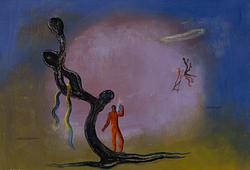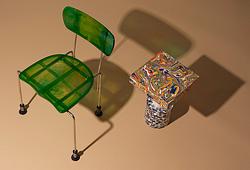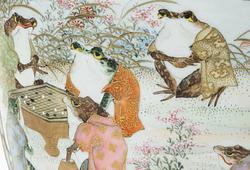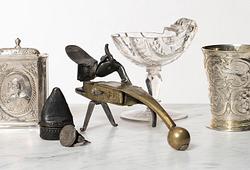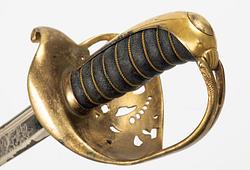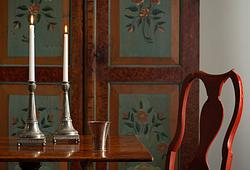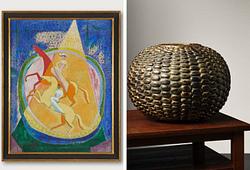Important Spring Sale presents highlights from the Silver Department
Unique filigree casket from the 17th century – an art historical masterpiece with an international touch
The auction's outstanding casket is a rare and complex work of art that carries a cultural and geographical heritage across several continents. What few people may not think about today is how international the Baroque was, the style spread via colonial countries when objects were specially commissioned in other parts of the world and sent to Europe.
The casket, which bears traces of both oriental and European craftsmanship – is made of silver and from the late 17th century, made in the ancient and exquisite filigree technique. The name of the technique derives from the Latin filum (thread) and granum (grain) and is characterized by intricate patterns in thin metal wire, often joined with small balls and decorative solders.
The panels executed in filigree technique may well have originated in Indonesia – perhaps Java, Sumatra, Jakarta or Goa in India – areas known for their exquisite filigree work during the period, often under Indo-Portuguese or Dutch colonial influence. At the same time, the assembly and certain stylistic features strongly indicate European, probably Swedish, manufacture: the lock plate, the handles and not least the European base plate with its inward-facing motif reminiscent of lids on tankards of the time. The enamel miniature, depicting Spes – the virtuous figure of hope – with an anchor is of a standardized type found on several objects from the time (see the silver ornament at the Nationalmuseum in Sweden, no. NMK CXV 1505).

Comparisons with preserved examples in the collections of, for example, Skokloster castle and the Nationalmuseum, as well as similarities with works by goldsmiths such as Rudolf Wittkopf, Johan Friedrich and Johann Heinrich Straub and Johan Ståhle, strengthen the hypothesis that the casket was assembled in Sweden. Wittkopf's two beakers with lids for King Charles XII of Sweden, now in the collections of the Nationalmuseum, bear several similarities to this casket. The Straub brothers, originally from Nuremberg – the European centre for filigree forging and assembly at the time – were active in Karlstad and Gothenburg in Sweden, and are known for having brought the technique here. It is precisely in this tension between international influence and local anchoring that this casket acquires its unique character.
The casket is adorned with six sparkling rubies, a carnelian, and characteristic diamond-shaped soldering – a style often linked to Swedish tradition. The applied rosettes, the cast figures and the border decoration on the edge of the lid are reminiscent of other Swedish works from the period. The motif of Jupiter with a thunderbolt in his hand carried by an eagle, a common feature in 17th-century German silver, adds further layers of symbolism and continental influences.
This casket lacks marks, which is common for objects of this type. But that is precisely what makes it an exciting and sought-after object – an object to explore, discuss and marvel at. A magnificent example of 17th century global craftsmanship – where Eastern detail meets the robust elegance of Swedish silver. The box is in unusually well-preserved condition as it has been stored in its original case made of pine and covered with embossed leather.

The piece will be sold at Important Spring Sale
Estimate 150 000 - 200 000 SEK
Viewing June 5–10, Berzelii Park 1, Stockholm
Open weekdays 11–18, weekends 11–16 CET
Live auction June 1–13, Arsenalsgatan 2, Stockholm
Read more about Important Spring Sale
More Silver Highlights at Important Spring Sale
Among the highlights of the auction are a pair of refined Rococo silver candelabra from 18th-century Stralsund by C.C. Papcke, as well as several impressive drinking vessels – including a partially gilded Baroque tankard by Daniel Schwestermüller, made in Augsburg between 1685 and 1687.
Also included is a two-tone gold and enamel snuffbox, likely from 19th-century Geneva, along with four Rococo silver candlesticks by Christian Drentwett II, dating from various parts of the 18th century. A cut-glass wine carafe with silver mounts, signed W.A. Bolin, Moscow, 1912–1917, is also part of the collection. Among the items are also 21 silver plates from Maison Odiot, Paris, produced in the latter half of the 19th century.

Hammer price
Unsold
Estimate
125 000 - 150 000 SEK

Hammer price
110 000 SEK
Estimate
125 000 - 150 000 SEK

Hammer price
55 000 SEK
Estimate
50 000 - 60 000 SEK

Hammer price
195 000 SEK
Estimate
100 000 - 125 000 SEK

Hammer price
65 000 SEK
Estimate
40 000 - 50 000 SEK

Hammer price
95 000 SEK
Estimate
100 000 - 120 000 SEK




